 Facebook
Facebook
 X
X
 Instagram
Instagram
 TikTok
TikTok
 Youtube
Youtube


While I wait to meet the Spider Lady, my mind involuntarily conjures a female version of Hairspray director John Waters. Surely someone who chooses to dedicate her life to caring for the very creatures that populate my nightmares must be a little off. She probably likes snakes too, I think.
When Paige Howorth finally does appear before me, I am so stunned by the gap between my expectations and reality that it takes me a few awkward seconds to return her smile and extend my hand to meet hers. She is young and pretty, fresh-faced and wide-eyed, with an 80s-style tousled mane of dark, curly hair. She looks like a cross between Jennifer Beals in Flashdance and Cher in Moonstruck. It is her jewelry, which she tells me she made herself, that finally betrays her occupation: dangling from the silver chains around her neck are silver castings of a tarantula fang and a Rhinoceros Beetle’s horn.
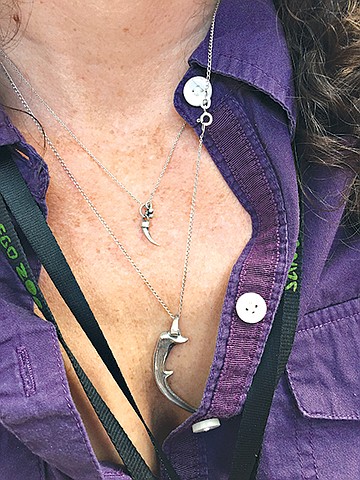
I refer to her as the Spider Lady, but Howorth’s actual title is Associate Curator of Entomology for the San Diego Zoo. Made official in 2009, the Department of Entomology is the zoo’s most recently established animal department. “We’re like the last kids at the party,” Howorth says. Which is strange to think about, she tells me, because without invertebrates, “zoos have been leaving out 96 percent of the wildlife population, and mammals make up less than one percent of all the biodiversity on earth.”
Howorth and her team recently converted an unused nursery nestled deep within the Children’s Zoo into what is now the zoo’s fourth invertebrate exhibit, the Arachnid Rescue Center. Here, zoo-goers can ogle at around 30 huge, eight-legged critters, a number of which are disturbingly furry (or adorably, depending on your feelings toward big furry spiders). It’s called the Arachnid Rescue Center because these diminutive beasties were seized during Operation Spiderman, a sting operation set up by the U.S. Fish & Wildlife Service to arrest and prosecute a German man who was smuggling hundreds of tarantulas into the United States from Mexico and South America.
“It doesn’t matter what it is, when you’re smuggling it, you can get caught,” Howorth says. “Fish and Wildlife had a total of about 300 specimens that were brought in by this guy until they finally said, ‘We have enough, we can move forward with arresting him and charging him.’” Of those 300 creepy-crawlies, the San Diego Zoo took in 80, and the rest went to other facilities belonging to the Association of Zoos and Aquariums, for which Howorth serves on the steering committee. “Within our network, we figured out who was going to be the best place for each species.”

Though the zoo began keeping and caring for them, all those arachnids still technically belonged to the government. “These are items we can’t just give away and sign a form and we’re done,” says Erin Dean, resident agent in charge at Fish and Wildlife. After making an arrest, it can take many months to obtain a conviction. There are currently at least 900 different species of tarantula that have been identified, and it’s not uncommon for smugglers to claim that the species in their possession are among those that are not protected by the Convention of International Trade in Endangered Species (CITES). Therefore, any animals that are seized by Fish and Wildlife must remain contained and available for inspection by experts and attorneys until a case is closed. “These are our evidence,” Dean says. “A lot of times, the defense council wants to examine items. They may need to be expertly identified.”
Dean says zoos have been “more than generous” by assuming guardianship of animals that have been seized. “It’s a lot to ask of these zoos, because they feed and take excellent care of these animals, sometimes for a long period of time. They can’t put [the animals] in permanent collections — they need to keep them separate, because that’s our evidence.” Though both entities work to protect wildlife, Dean clarifies, “the zoos’ focus is on the welfare of the animal,” while Fish and Wildlife, as a law enforcement agency, works on “catching the bad guys.”
Operation Spiderman was an investigation that lasted 10 months. The smuggler eventually pleaded guilty and was sentenced to six months in prison (the maximum he could have received is 20 years). He also had to pay a $4000 fine. Once the case was resolved, the San Diego Zoo placed all but 30 of the arachnids elsewhere. The zoo assumed ownership of the animals, but they had no public space in which to display them, until now.
At approximately 12 by 14 feet, the Arachnid Rescue Center is a small room, kept at a balmy 77 degrees. A humidifier in the corner keeps the air moist, similar to most of the spiders’ hometowns in the Amazon region or the mountains of central Mexico. Stacked on steel shelves against two opposing walls are the enclosures — small glass boxes lined up like aquariums in a pet store. A third wall is mostly glass, on the other side of which spectators can gather. Just inside the glass wall is a “small stage” featuring a display of spider husks (hairy, life-like exoskeletons). On each side of that is an enclosure holding a live tarantula. These will be switched out intermittently, as different animals get their turn in the spotlight.
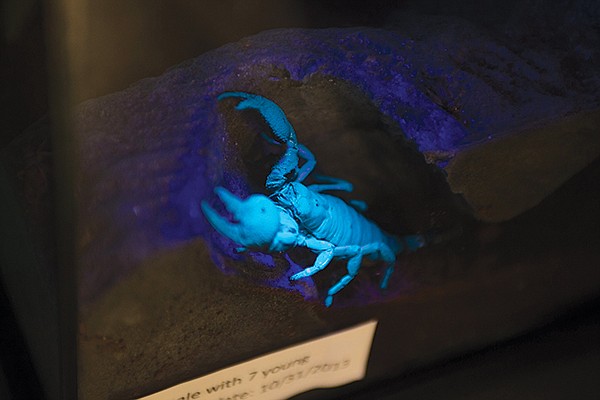
Opposite the window wall is a kitchenette. At first glance, it looks like your standard office kitchen: a large-basin sink flanked by white cupboards, a drying rack, a knife board over the sink, and a framed print of illustrations similar to those on the back of Cook’s Illustrated that depict multiple varieties of one kind of food, such as mushrooms. It’s only when I step closer that I realize the drawings are not whimsical food sketches, but scientific illustrations of spiders and insects. And stuck to the “knife” board, were a series of long-pronged implements — giant tweezers, primarily used, I was about to observe, for feeding live crickets to tarantulas and scorpions.

In the middle of the space is a metal table similar to those I’ve seen in the examination rooms of veterinary clinics. Howorth selects an enclosure from one of the shelves and places it on the table. “This is Vivica,” she says, gesturing at the Brazilian Black tarantula between us. As I gaze at Vivica’s glossy black fur, I almost forget about my own mild case of arachnophobia. Somehow, its large size made the spider seem less creepy; more like my old pet rat than a multiple-legged monster.
Female tarantulas live for around 20 years, and take seven years to mature. Vivica is about as big as my hand now, but when she first made it to the States, she was one of 250 baby tarantulas hidden in a straw that had been taped shut at either end. The idea of that many spiderlings in one place made me shudder. I couldn’t imagine what it would be like to discover such a package. What kept any warm-blooded border agent from shrieking and stomping on the bugs?
“My first job as a wildlife inspector, I’ll never forget it,” says Dean. “Reptiles and spiders were not really my thing. It was 1993, and there were 427 live tarantulas smuggled across the border. As a new recruit, I was given the task of caring for these little creatures, along with my training officer. We had to separate them — you can’t put them together, they’d fight and kill each other. We had to feed, water, and care for these tarantulas until we could find a home for them. Honestly, I remember having nightmares from dealing with all of those spiders.”
Howorth puts on safety glasses, and says I shouldn’t need any, as I am already wearing glasses. “Why in the world would we need to protect our eyes in here?” I say. “Do I even want to know?”
The entomologist ensures me I have nothing to worry about, that the zoo errs on the side of caution. She then points at Vivica’s abdomen and says, “These new world tarantulas have a patch of what’s called urticating hairs — it’s a defense mechanism. Basically, it uses its hind legs to flick those hairs off, and they’re barbed, and they can lodge in your eyes and your mucus membranes and your skin.”
Howorth smiles warmly, and tells me that Vivica rarely uses her urticating hairs. This from the woman who uses the term “puppy dogs” when referring to Brazilian Blacks. “They are my favorite tarantula in the world,” she says. “They’re so gentle and so beautiful. It’s hard to assign any kind of personality traits to tarantulas, but if you had to, this species — there’s just something about them. Their behavioral responses to things are so different. White Knee tarantulas are much less tolerant of any disturbance or activity in their vicinity, so their defenses are activated more quickly than a Black Beauty’s would be. For example, I wouldn’t handle a Brazilian White Knee.”
I lean down beside the enclosure and peer through the glass. “You know,” I say, “even though I know my mental cinema is going to play a nightmare of this thing breaking out of that cage and attacking me, I have to admit, it is pretty. I would almost venture to pet it right now if I didn’t think it would kick those spiky hairs off its butt at me.”
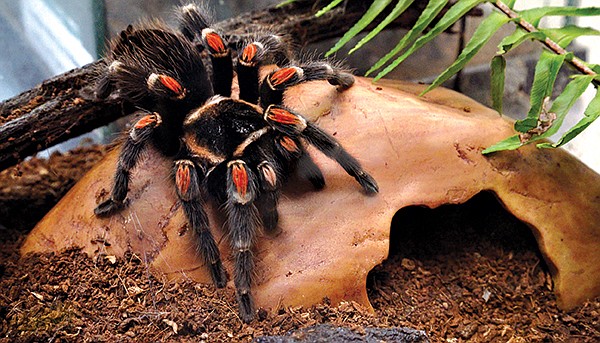
Howorth returns the Brazilian Black back to the shelf and then places an enclosure containing a Brachypelma, or Mexican Flame Knee tarantula, on the table. “These look like they have red velvet pants on,” she says. She retrieves a tall, cylindrical plastic container and a pair of long tweezers from the knife rack over the sink, and then removes the lid on the Flame Knee’s enclosure. I recoil. Howorth notes my reaction, and shares a few factoids intended to put me at ease. “The biggest misconception about spiders is that they’re going to come after you, or jump at you,” she says. “But they don’t have legs like grasshopper legs, they don’t have that spring in their steps.”
I start to relax, but then she adds, “Of course, the arboreal species — because they’re living in the crotch of a tree — they’ll jump out and grab something, but they’re not ‘jumping’ so much as moving really quickly. It’s scary for people, I get that.”
Yes, yes it is, I think. But, Howorth insists, people don’t need to be concerned even if a tarantula does catch them. “It’s typically not a medically important bite. It’s more like getting a bee sting. Almost all the tarantulas in this room — sure, it would be scary and painful at first, but it’s not like, you know....”
By “you know,” I’m fairly certain she means “slow and painful death.” I’m glad to hear a tarantula bite won’t kill me, but I still keep my distance.
Because spectators can only see a few arachnids at a time from the other side of the glass, this exhibit is designed to be more like a visible lab. Zookeepers will be in the room every day, wearing microphones so that they can communicate what they’re doing to anyone who’s outside looking in. “A lot of people are afraid of spiders,” Howorth says, evoking a loud, “Duh,” from me. “But when the keepers are in here, they’ll do feedings in view of the public, and explain the value of these animals — beyond just their intrinsic value. They’ll talk about why we want to make sure we don’t lose them, and what is being done to combat the effects of wildlife trafficking.”
Howorth uses the long tweezers to capture a live cricket from the plastic container. As she moves toward the other side of the enclosure, to get closer to the opening on top, the cricket escapes the tweezer’s grip. In a crouch, Howorth chases the cricket around the room, her hands cupped and her arms outstretched. Finally, she catches the insect, and positions it between the tweezer’s tips once more.
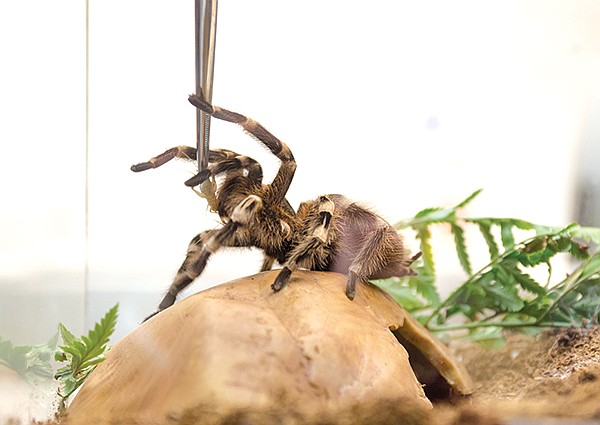
I comment on how little webbing is inside the enclosure. As she deposits the cricket very close to the tarantula’s “face,” Howorth explains, “Their food is never going to get stuck in a web.” Instead, these spiders sense the vibrations of the cricket moving around outside their burrows. The Flame Knee swiftly snatches the cricket and pushes it deep into its mouth, using its pedipalps — tiny appendages that work like hands — to hold and tear the food. As my face scrunches in disgust, Howorth describes how the arachnid is injecting digestive enzymes into the cricket. “Eventually, there will just be the inedible parts left, then she’ll kind of work it with her fangs. They have a sucking stomach, so they juice it and suck it, until there’s just a husk left, or if it’s a vertebrate, a little knob of a skeleton.”
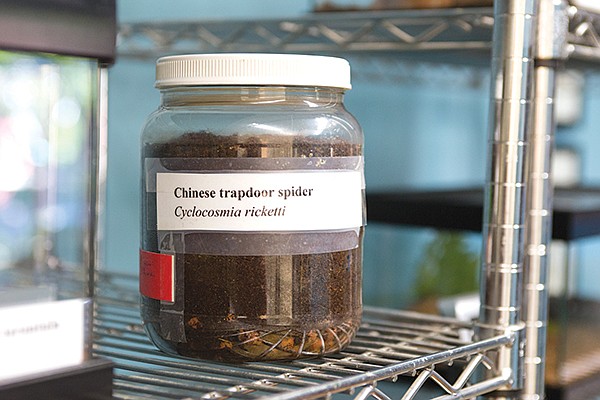
Howorth’s favorite creature in the room is the only one I am unable to see. She holds up a small glass jar filled with dirt. Somewhere in there is a Chinese Trapdoor spider. “When we got this animal I was like, ‘Wow, I’ve never seen that before.’ It was amazing,” Howorth says. “Hardly anything is known about them. Obviously they’re predators: they make a burrow straight down into the soil, and create this trapdoor out of silk, debris and soil. If you can get past that trapdoor, they can close off the passage with their abdomen. These spiders have an unusual hardening of the exoskeleton at the end of their abdomen that resembles a door with carved symbols.” She tells me the Chinese Trapdoor is thought to plug the “door” to their burrow with their unusual, flat abdomen. “It looks like someone created it — they have these beautiful patterns, like something you could put in a stamp pad and make this really cool design.”
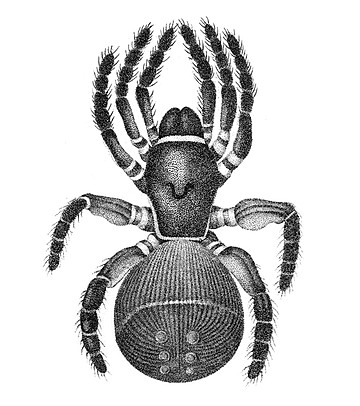
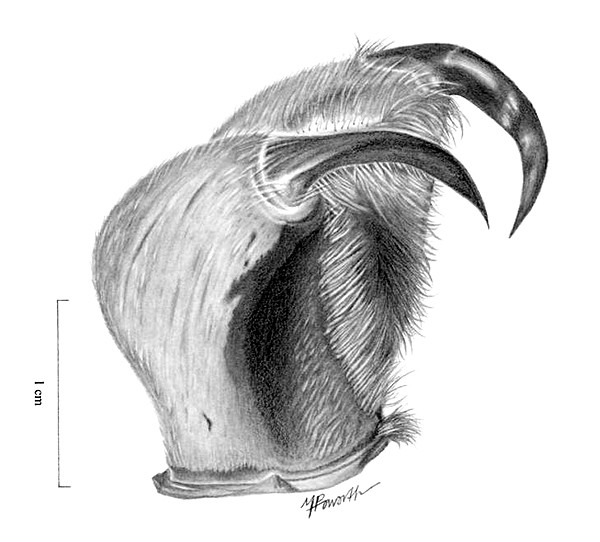
Unfortunately, the zoo has not yet figured out how to display the Chinese Trapdoor spider; for now, the only evidence of it is that jar of dirt. It’s the most interesting specimen in the room, and no one can see it. “You should call it Snuffleupagus,” I say, after Big Bird’s imaginary (and very fuzzy) Mammoth friend on Sesame Street. I am told, to my extreme delight, that my suggestion will be considered — unlike Vivica and a 15-year-old bird-eating spider named Charlie, the Chinese Trapdoor spider does not yet have a name.
A group of children appear at the glass window. A boy bangs on the glass, and I glare at him. “Kids who bang on the glass at the zoo” is right up there with “drivers of SUVs who take up two parking spaces” and “theater-goers who talk during the show” on my “People to be Abhorred” list. A young girl shouts, “Eww, spiders!” Another girl, about a year older than the first, says, “This one’s dead. Oh! There’s another one over there!”
As she watches the children, Howorth smiles. “This is what I want,” she says. “I want them to discover it, to not be afraid. Whether people like [spiders] or not, the reaction is always visceral. Either they’re like, ‘Awesome!’ or they’re freaked out. But then you have their attention, and you can say something. And you should say something, you know?”
We watch the children run off to the next exhibit, and Howorth continues smiling after them, the same way she’d smiled at her arachnids.



While I wait to meet the Spider Lady, my mind involuntarily conjures a female version of Hairspray director John Waters. Surely someone who chooses to dedicate her life to caring for the very creatures that populate my nightmares must be a little off. She probably likes snakes too, I think.
When Paige Howorth finally does appear before me, I am so stunned by the gap between my expectations and reality that it takes me a few awkward seconds to return her smile and extend my hand to meet hers. She is young and pretty, fresh-faced and wide-eyed, with an 80s-style tousled mane of dark, curly hair. She looks like a cross between Jennifer Beals in Flashdance and Cher in Moonstruck. It is her jewelry, which she tells me she made herself, that finally betrays her occupation: dangling from the silver chains around her neck are silver castings of a tarantula fang and a Rhinoceros Beetle’s horn.

I refer to her as the Spider Lady, but Howorth’s actual title is Associate Curator of Entomology for the San Diego Zoo. Made official in 2009, the Department of Entomology is the zoo’s most recently established animal department. “We’re like the last kids at the party,” Howorth says. Which is strange to think about, she tells me, because without invertebrates, “zoos have been leaving out 96 percent of the wildlife population, and mammals make up less than one percent of all the biodiversity on earth.”
Howorth and her team recently converted an unused nursery nestled deep within the Children’s Zoo into what is now the zoo’s fourth invertebrate exhibit, the Arachnid Rescue Center. Here, zoo-goers can ogle at around 30 huge, eight-legged critters, a number of which are disturbingly furry (or adorably, depending on your feelings toward big furry spiders). It’s called the Arachnid Rescue Center because these diminutive beasties were seized during Operation Spiderman, a sting operation set up by the U.S. Fish & Wildlife Service to arrest and prosecute a German man who was smuggling hundreds of tarantulas into the United States from Mexico and South America.
“It doesn’t matter what it is, when you’re smuggling it, you can get caught,” Howorth says. “Fish and Wildlife had a total of about 300 specimens that were brought in by this guy until they finally said, ‘We have enough, we can move forward with arresting him and charging him.’” Of those 300 creepy-crawlies, the San Diego Zoo took in 80, and the rest went to other facilities belonging to the Association of Zoos and Aquariums, for which Howorth serves on the steering committee. “Within our network, we figured out who was going to be the best place for each species.”

Though the zoo began keeping and caring for them, all those arachnids still technically belonged to the government. “These are items we can’t just give away and sign a form and we’re done,” says Erin Dean, resident agent in charge at Fish and Wildlife. After making an arrest, it can take many months to obtain a conviction. There are currently at least 900 different species of tarantula that have been identified, and it’s not uncommon for smugglers to claim that the species in their possession are among those that are not protected by the Convention of International Trade in Endangered Species (CITES). Therefore, any animals that are seized by Fish and Wildlife must remain contained and available for inspection by experts and attorneys until a case is closed. “These are our evidence,” Dean says. “A lot of times, the defense council wants to examine items. They may need to be expertly identified.”
Dean says zoos have been “more than generous” by assuming guardianship of animals that have been seized. “It’s a lot to ask of these zoos, because they feed and take excellent care of these animals, sometimes for a long period of time. They can’t put [the animals] in permanent collections — they need to keep them separate, because that’s our evidence.” Though both entities work to protect wildlife, Dean clarifies, “the zoos’ focus is on the welfare of the animal,” while Fish and Wildlife, as a law enforcement agency, works on “catching the bad guys.”
Operation Spiderman was an investigation that lasted 10 months. The smuggler eventually pleaded guilty and was sentenced to six months in prison (the maximum he could have received is 20 years). He also had to pay a $4000 fine. Once the case was resolved, the San Diego Zoo placed all but 30 of the arachnids elsewhere. The zoo assumed ownership of the animals, but they had no public space in which to display them, until now.
At approximately 12 by 14 feet, the Arachnid Rescue Center is a small room, kept at a balmy 77 degrees. A humidifier in the corner keeps the air moist, similar to most of the spiders’ hometowns in the Amazon region or the mountains of central Mexico. Stacked on steel shelves against two opposing walls are the enclosures — small glass boxes lined up like aquariums in a pet store. A third wall is mostly glass, on the other side of which spectators can gather. Just inside the glass wall is a “small stage” featuring a display of spider husks (hairy, life-like exoskeletons). On each side of that is an enclosure holding a live tarantula. These will be switched out intermittently, as different animals get their turn in the spotlight.

Opposite the window wall is a kitchenette. At first glance, it looks like your standard office kitchen: a large-basin sink flanked by white cupboards, a drying rack, a knife board over the sink, and a framed print of illustrations similar to those on the back of Cook’s Illustrated that depict multiple varieties of one kind of food, such as mushrooms. It’s only when I step closer that I realize the drawings are not whimsical food sketches, but scientific illustrations of spiders and insects. And stuck to the “knife” board, were a series of long-pronged implements — giant tweezers, primarily used, I was about to observe, for feeding live crickets to tarantulas and scorpions.

In the middle of the space is a metal table similar to those I’ve seen in the examination rooms of veterinary clinics. Howorth selects an enclosure from one of the shelves and places it on the table. “This is Vivica,” she says, gesturing at the Brazilian Black tarantula between us. As I gaze at Vivica’s glossy black fur, I almost forget about my own mild case of arachnophobia. Somehow, its large size made the spider seem less creepy; more like my old pet rat than a multiple-legged monster.
Female tarantulas live for around 20 years, and take seven years to mature. Vivica is about as big as my hand now, but when she first made it to the States, she was one of 250 baby tarantulas hidden in a straw that had been taped shut at either end. The idea of that many spiderlings in one place made me shudder. I couldn’t imagine what it would be like to discover such a package. What kept any warm-blooded border agent from shrieking and stomping on the bugs?
“My first job as a wildlife inspector, I’ll never forget it,” says Dean. “Reptiles and spiders were not really my thing. It was 1993, and there were 427 live tarantulas smuggled across the border. As a new recruit, I was given the task of caring for these little creatures, along with my training officer. We had to separate them — you can’t put them together, they’d fight and kill each other. We had to feed, water, and care for these tarantulas until we could find a home for them. Honestly, I remember having nightmares from dealing with all of those spiders.”
Howorth puts on safety glasses, and says I shouldn’t need any, as I am already wearing glasses. “Why in the world would we need to protect our eyes in here?” I say. “Do I even want to know?”
The entomologist ensures me I have nothing to worry about, that the zoo errs on the side of caution. She then points at Vivica’s abdomen and says, “These new world tarantulas have a patch of what’s called urticating hairs — it’s a defense mechanism. Basically, it uses its hind legs to flick those hairs off, and they’re barbed, and they can lodge in your eyes and your mucus membranes and your skin.”
Howorth smiles warmly, and tells me that Vivica rarely uses her urticating hairs. This from the woman who uses the term “puppy dogs” when referring to Brazilian Blacks. “They are my favorite tarantula in the world,” she says. “They’re so gentle and so beautiful. It’s hard to assign any kind of personality traits to tarantulas, but if you had to, this species — there’s just something about them. Their behavioral responses to things are so different. White Knee tarantulas are much less tolerant of any disturbance or activity in their vicinity, so their defenses are activated more quickly than a Black Beauty’s would be. For example, I wouldn’t handle a Brazilian White Knee.”
I lean down beside the enclosure and peer through the glass. “You know,” I say, “even though I know my mental cinema is going to play a nightmare of this thing breaking out of that cage and attacking me, I have to admit, it is pretty. I would almost venture to pet it right now if I didn’t think it would kick those spiky hairs off its butt at me.”

Howorth returns the Brazilian Black back to the shelf and then places an enclosure containing a Brachypelma, or Mexican Flame Knee tarantula, on the table. “These look like they have red velvet pants on,” she says. She retrieves a tall, cylindrical plastic container and a pair of long tweezers from the knife rack over the sink, and then removes the lid on the Flame Knee’s enclosure. I recoil. Howorth notes my reaction, and shares a few factoids intended to put me at ease. “The biggest misconception about spiders is that they’re going to come after you, or jump at you,” she says. “But they don’t have legs like grasshopper legs, they don’t have that spring in their steps.”
I start to relax, but then she adds, “Of course, the arboreal species — because they’re living in the crotch of a tree — they’ll jump out and grab something, but they’re not ‘jumping’ so much as moving really quickly. It’s scary for people, I get that.”
Yes, yes it is, I think. But, Howorth insists, people don’t need to be concerned even if a tarantula does catch them. “It’s typically not a medically important bite. It’s more like getting a bee sting. Almost all the tarantulas in this room — sure, it would be scary and painful at first, but it’s not like, you know....”
By “you know,” I’m fairly certain she means “slow and painful death.” I’m glad to hear a tarantula bite won’t kill me, but I still keep my distance.
Because spectators can only see a few arachnids at a time from the other side of the glass, this exhibit is designed to be more like a visible lab. Zookeepers will be in the room every day, wearing microphones so that they can communicate what they’re doing to anyone who’s outside looking in. “A lot of people are afraid of spiders,” Howorth says, evoking a loud, “Duh,” from me. “But when the keepers are in here, they’ll do feedings in view of the public, and explain the value of these animals — beyond just their intrinsic value. They’ll talk about why we want to make sure we don’t lose them, and what is being done to combat the effects of wildlife trafficking.”
Howorth uses the long tweezers to capture a live cricket from the plastic container. As she moves toward the other side of the enclosure, to get closer to the opening on top, the cricket escapes the tweezer’s grip. In a crouch, Howorth chases the cricket around the room, her hands cupped and her arms outstretched. Finally, she catches the insect, and positions it between the tweezer’s tips once more.

I comment on how little webbing is inside the enclosure. As she deposits the cricket very close to the tarantula’s “face,” Howorth explains, “Their food is never going to get stuck in a web.” Instead, these spiders sense the vibrations of the cricket moving around outside their burrows. The Flame Knee swiftly snatches the cricket and pushes it deep into its mouth, using its pedipalps — tiny appendages that work like hands — to hold and tear the food. As my face scrunches in disgust, Howorth describes how the arachnid is injecting digestive enzymes into the cricket. “Eventually, there will just be the inedible parts left, then she’ll kind of work it with her fangs. They have a sucking stomach, so they juice it and suck it, until there’s just a husk left, or if it’s a vertebrate, a little knob of a skeleton.”

Howorth’s favorite creature in the room is the only one I am unable to see. She holds up a small glass jar filled with dirt. Somewhere in there is a Chinese Trapdoor spider. “When we got this animal I was like, ‘Wow, I’ve never seen that before.’ It was amazing,” Howorth says. “Hardly anything is known about them. Obviously they’re predators: they make a burrow straight down into the soil, and create this trapdoor out of silk, debris and soil. If you can get past that trapdoor, they can close off the passage with their abdomen. These spiders have an unusual hardening of the exoskeleton at the end of their abdomen that resembles a door with carved symbols.” She tells me the Chinese Trapdoor is thought to plug the “door” to their burrow with their unusual, flat abdomen. “It looks like someone created it — they have these beautiful patterns, like something you could put in a stamp pad and make this really cool design.”


Unfortunately, the zoo has not yet figured out how to display the Chinese Trapdoor spider; for now, the only evidence of it is that jar of dirt. It’s the most interesting specimen in the room, and no one can see it. “You should call it Snuffleupagus,” I say, after Big Bird’s imaginary (and very fuzzy) Mammoth friend on Sesame Street. I am told, to my extreme delight, that my suggestion will be considered — unlike Vivica and a 15-year-old bird-eating spider named Charlie, the Chinese Trapdoor spider does not yet have a name.
A group of children appear at the glass window. A boy bangs on the glass, and I glare at him. “Kids who bang on the glass at the zoo” is right up there with “drivers of SUVs who take up two parking spaces” and “theater-goers who talk during the show” on my “People to be Abhorred” list. A young girl shouts, “Eww, spiders!” Another girl, about a year older than the first, says, “This one’s dead. Oh! There’s another one over there!”
As she watches the children, Howorth smiles. “This is what I want,” she says. “I want them to discover it, to not be afraid. Whether people like [spiders] or not, the reaction is always visceral. Either they’re like, ‘Awesome!’ or they’re freaked out. But then you have their attention, and you can say something. And you should say something, you know?”
We watch the children run off to the next exhibit, and Howorth continues smiling after them, the same way she’d smiled at her arachnids.
Comments